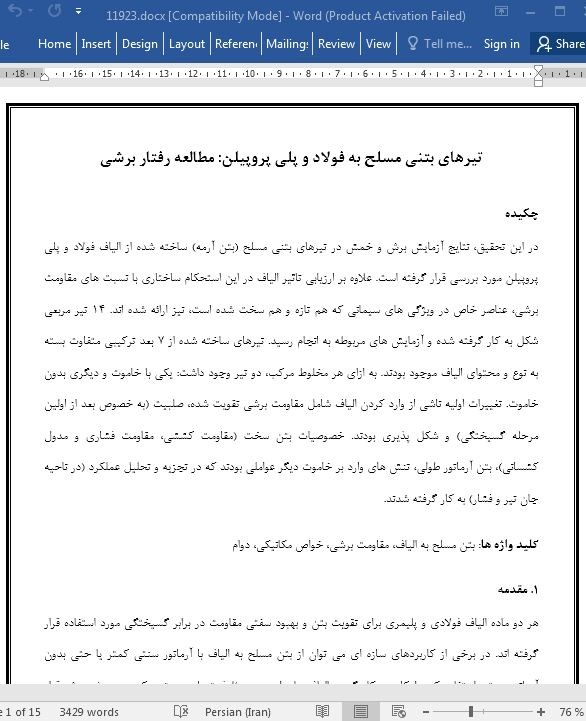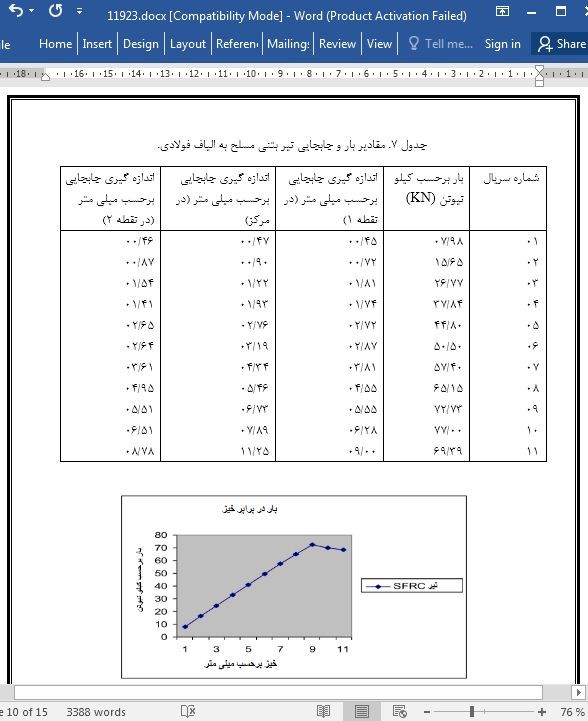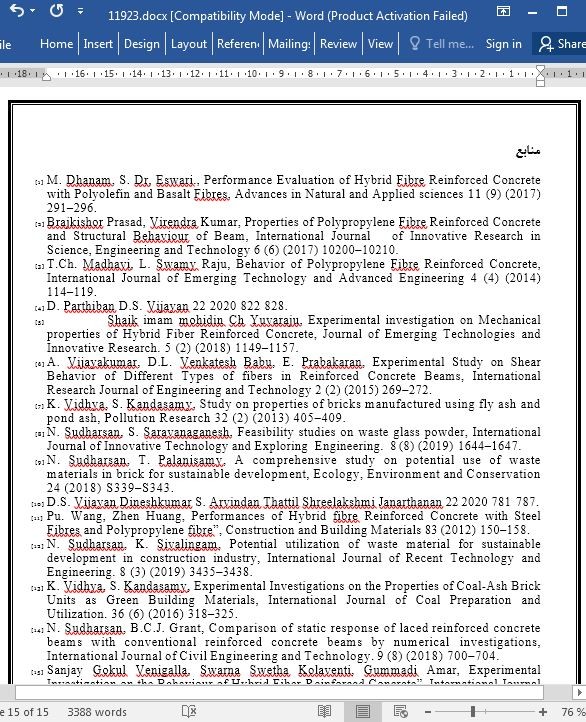
تیرهای بتنی مسلح به فولاد و پلی پروپیلن
چکیده
در این تحقیق، نتایج آزمایش برش و خمش در تیرهای بتنی مسلح (بتن آرمه) ساخته شده از الیاف فولاد و پلی پروپیلن مورد بررسی قرار گرفته است. علاوه بر ارزیابی تاثیر الیاف در این استحکام ساختاری با نسبت های مقاومت برشی، عناصر خاص در ویژگی های سیمانی که هم تازه و هم سخت شده است، نیز ارائه شده اند. ۱۴ تیر مربعی شکل به کار گرفته شده و آزمایش های مربوطه به انجام رسید. تیرهای ساخته شده از ۷ بعد ترکیبی متفاوت بسته به نوع و محتوای الیاف موجود بودند. به ازای هر مخلوط مرکب، دو تیر وجود داشت: یکی با خاموت و دیگری بدون خاموت. تغییرات اولیه ناشی از وارد کردن الیاف شامل مقاومت برشی تقویت شده، صلبیت (به خصوص بعد از اولین مرحله گسیختگی) و شکل پذیری بودند. خصوصیات بتن سخت (مقاومت کششی، مقاومت فشاری و مدول کشسانی)، بتن آرماتور طولی، تنش های وارد بر خاموت دیگر عواملی بودند که در تجزیه و تحلیل عملکرد (در ناحیه جان تیر و فشار) به کار گرفته شدند.
۱. مقدمه
هر دو ماده الیاف فولادی و پلیمری برای تقویت بتن و بهبود سفتی مقاومت در برابر گسیختگی مورد استفاده قرار گرفته اند. در برخی از کاربردهای سازه ای می توان از بتن مسلح به الیاف با آرماتور سنتی کمتر یا حتی بدون آرماتور سنتی استفاده کرد. امکان به کار گیری الیاف ها برای بهبود ظرفیت باربری بتنی که در معرض برش قرار گرفته است، وجود داشت. هم چنین، تکنیک های طراحی مختلفی ارائه شده است که افزایش مقاومت برشی ناشی از الیاف را مدنظر قرار می دهند. در هر روش، از یک شاخص مبتنی بر سختی مواد برای تبیین توزیع الیاف استفاده می شود. با این حال، هر فرمول از یک شاخص متفاوت بدست آمده از چیدمان های آزمایش مختلف بهره می گیرد [۵].
Abstract
The research examines the outcomes of shear and flexure testing on reinforced concrete beams made from steel and polypropylene fibre. As well as assessing the impact of fibre in this structural integrity with shear strengthening ratios, certain elements in the characteristics of the cement that is both new and hardened are presented. 14 square beams being put into practice. Tests were made. There were beams produced from 7 distinct mixing dimensions, depending on the kind and the fibre content. For each composite mix there were two beams: one with and the other without stirrups. The primary changes caused by the introduction of fibres were enhanced shear strength, rigidity (especially after the first breaking stage) and ductility. The characteristics of hard concrete (tensile strength, compressive strength and elasticity modules), longitudinal reinforcement concrete, stresses in stirrups, were other factors utilized for the analysis of performance (at the compression and web zone).
1. Introduction
Steel and polymeric fibres both of these materials have been used to strengthen concrete, improving its toughness of fracture resistance. In some structural applications, fibre-reinforced concrete can be utilized with less or even no traditional reinforcement. The fibres could be put to use improve the load-carrying capacity of concrete that has been exposed to shear. Several design techniques that account for the increase in shear strength caused by fibres have been presented. Each approach uses an index based on the material’s hardness to account for the fibre contribution. Each formula, however, employs a different index derived from various test setups [5].
چکیده
۱. مقدمه
2. بررسی آثار
3. برنامه تجربی
3.1. ویژگی های مواد تشکیل دهنده
۳.۲. طراحی ترکیبی
4. نتایج آزمایش و مباحث
۴.۱. نتایج تجربی
۵. نتیجه گیری
منابع
Abstract
Keywords
1. Introduction
2. Literature review
3. Experimental program
3.1. Properties of constituent materials
4. Test results and discussions
4.1. Experimental results
5. Conclusion
Declaration of Competing Interest
References
- اصل مقاله انگلیسی با فرمت ورد (word) با قابلیت ویرایش
- ترجمه فارسی مقاله با فرمت ورد (word) با قابلیت ویرایش، بدون آرم سایت ای ترجمه
- ترجمه فارسی مقاله با فرمت pdf، بدون آرم سایت ای ترجمه



